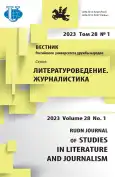Path to Viy: features of the artistic conflict
- Authors: Khomyakova O.R.1
-
Affiliations:
- Belarusian State Pedagogical University named after Maxim Tank
- Issue: Vol 28, No 1 (2023)
- Pages: 7-20
- Section: LITERARY CRITICISM
- URL: https://journal-vniispk.ru/2312-9220/article/view/319038
- DOI: https://doi.org/10.22363/2312-9220-2023-28-1-7-20
- EDN: https://elibrary.ru/IEPXEQ
- ID: 319038
Cite item
Full Text
Abstract
The author undertakes a study of the symbolic-religious conflict, a man and Viy, as a structural and content basis for the integrity of the novella Viy . In Gogol's “paradoxical negative realism”, the “squabbling of life” is depicted from an eschatological perspective. The heterogeneity of the conflict is predetermined by the heterogeneity of Gogol's vision of life: behind the vulgar relations of vulgar people, an existential world, invisible to the characters, shines through, in which an irreal enemy awaits a person in order not to allow this person to avoid meeting with himself. The basis of the conflict of the novella Viy is the subterranean phenomena of the universe, which are at different stages of accepting evil. The mutual negation of the vulgarity of evil (Khoma) and the fantasy of supernatural evil (Viy) does not seem to Gogol absolute, just as the scenario of their movement towards each other does not seem impossible. Analysis of the conflict allows us to assert that Gogol, as a “prophet and philosopher of Orthodox culture”, according to V. Zenkovsky's definition, declares himself already in the story of 1834, and Russian literature owes the “implantation of the religious theme” to this particular work.
Keywords
About the authors
Olga R. Khomyakova
Belarusian State Pedagogical University named after Maxim Tank
Author for correspondence.
Email: hom_o@rambler.ru
ORCID iD: 0000-0001-7010-7696
Candidate of Philology, Associate Professor of the Department of Belarusian and Foreign Philology
18 Sovetskaya St, Minsk, 220050, Republic of BelarusReferences
- Averintsev, S.S. (1971). Greek literature and near east verbal culture. Typology and Interactions of the Ancient Literatures (pp. 206–266). Moscow. (In Russ.)
- Bahtin, M.M. (1979). Aesthetics of verbal creativity. Moskva: Iskusstvo Publ. (In Russ.)
- Bulgakov, S.N. (1994). The nonevening light: Contemplation and speculation. Moscow: Respublika Publ. (In Russ.)
- Gippius, V. (1994). Gogol. In V. Gippius. Gogol. V.V. Zenkovskiy. N. Gogol. St. Petersburg: Logos Publ. (In Russ.)
- Gogol, N.V. (1937). Complete works (vol. 2). Moscow: AN SSSR Publ. (In Russ.)
- Gogol, N.V. Collection of works (V.A. Voropaev, I.A. Vinogradov, drafting, preparation of texts and comments). Moscow: Russkaya Kniga Publ. (In Russ.)
- Goldenberg, A.X. (2007). Archetypes in the poetics of N.V. Gogol. Volgograd: Peremena Publ. (In Russ.).
- Gulyaev, R.V. (2015). The philosopher in front of the speechless horror (on “Viy” by N.V. Gogol). Voprosy Filosofii, 9, 103–113. (In Russ.)
- Hardy, J.D., & Stanton, L. (2002). Magical realism in the tales of Nikolai Gogol. Janus Head, 5(2), 126–139. https://doi.org/10.5840/jh20025227
- Jackson, R. (2013). Fantasy. Taylor and Francis. https://doi.org/10.4324/9781315015958
- Swensen, A. (1993). Vampirism in Gogol’s short fiction. Slavic and East European Journal, 37(4), 490–509. https://doi.org/10.2307/308458
Supplementary files









